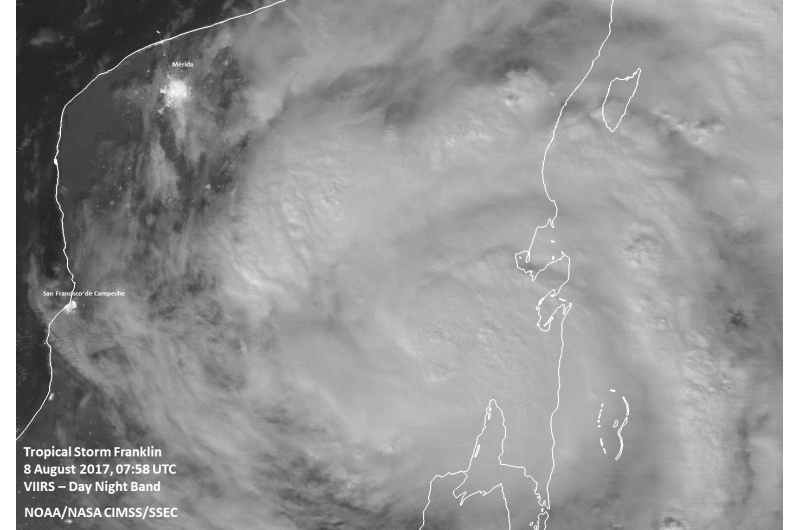A satellite from a Finnish nuclear power plant takes a double look at the tropical storm Franklin
Infrared image of Franklin NASA-NOAA satellite from the Finnish Nuclear Power Plant on August 8 at 3.58 EDT (0758 UTC showed clouds around the low-level center were as cold as 190 Kelvin (minus 117.7 degrees Fahrenheit / minus 83.1 degrees Celsius). Credits: NASA / NOAA / UWM-CIMSS, William Straka III
As a satellite from NASA-NOAA’s Finnish nuclear power plant passed over the Tropical Storm, Franklin’s instruments provided a view of the storm clouds during the night and measured their temperatures, revealing an intensifying storm.
The VIIRS (Visible Infrared Imaging Radiometer Suite) device at the NASA-NOAA Finland nuclear power plant took infrared images of Franklin on August 8 at 3.58 EDT (0758 UTC). The night view of the Finnish nuclear power plant showed that the northwestern edge of Franklin had not yet reached San Francisco de Campeche or Merida, as the lights of both cities were still visible in the picture. The infrared image provided temperatures from the peaks of the Franklin cloud, where thunderstorms around the low-level center were as cold as 190 Kelvin (minus 117.7 degrees Fahrenheit / minus 83.1 degrees Celsius). NASA studies have shown that storms with cold cloud temperatures can cause very heavy rainfall.
By early August 9, Franklin Center had slipped off the ground and ascended to Campeche Bay in the Gulf of Southwest Mexico.
The National Hurricane Center noted that a hurricane warning is in effect off the coast of Mexico from Puerto de Veracruz to Cabo Rojo as Franklin is expected to intensify into a hurricane before its second landing. Hurricane Watch is also valid off the coast of Mexico north of Cabo Rojo in Rio Panuco and a tropical storm warning is valid off the coast of Mexico from Puerto de Veracruz east to Puerto Dos Bocas and off the coast of Mexico north of Tuxpan. Barra del Tordo.

NASA-NOAA A satellite from a Finnish nuclear power plant took a picture of tonight’s tropical storm in Franklin on August 8 at 3.58 EDT (0758 UTC) on the Yucatan Peninsula in Mexico. At that time, the northwestern edge of Franklin had not yet reached San Francisco de Campeche or Merida, as the lights of both cities were still visible in the picture. Acknowledgments: NASA / NOAA / UWM-CIMSS, William Straka III
At 11 a.m. (1,500 UTC), the Franklin Center for the tropical storm was located near 20.2 degrees north latitude and 93.9 degrees west longitude. This locates downtown Franklin about 140 miles (230 km) northeast of Coatzacoalcos, Mexico and about 165 miles (265 km) northeast of Veracruz in Mexico.
Franklin is moving west at 13 mph (20 km / h) and this general movement is expected to continue around the next day. On the forecast route, downtown Franklin is expected to approach the coast of eastern Mexico today and then cross the coast in the state of Veracruz, Mexico, tonight or early Thursday, Aug. 10. The maximum continuous wind speed is close to 70 mph (110 km / h). higher gusts and the National Hurricane Center said Franklin is forecast to turn into a hurricane later today and reach the Mexican coast as a hurricane tonight or early Thursday.
NASA is following the tropical storm Franklin
Quotation: Satellite from Finnish nuclear power plant examines Tropical Storm Franklin twice (2017, August 9), retrieved on April 7, 2022 from https://phys.org/news/2017-08-english-npp-satellite-tropical-storm.html
This document is subject to copyright. No part may be reproduced without our written permission, except for fair trade for private study or research. The content is for informational purposes only.




